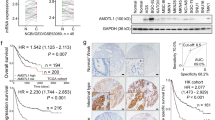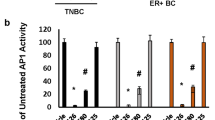Abstract
ARK5, AMP-activated protein kinase (AMPK)-related protein kinase mediating Akt signals, is closely involved in tumor progression, and its stage-associated expression was observed in colorectal cancer. In this study, we found ARK5 expression in multiple myeloma cell lines expressing c-MAF and MAFB. In addition, gene expression profiling of 351 clinical specimens revealed ARK5 expression in primary myelomas expressing c-MAF and MAFB, suggesting that ARK5 may be a transcriptional target of the Large-MAF family. Sequence analysis of the ARK5 gene promoter revealed that it contains two putative MAF-recognition element (MARE) sequences. In support of this hypothesis, ARK5 was induced when an MAFB or c-MAF expression vector was introduced into non-ARK5-expressing colon cancer cells. Furthermore, ARK5 promoter activity was dramatically decreased by mutation or deletion of MARE sequences. Chromatin immunoprecipitation assays revealed an interaction between the Large-MAF family proteins and MARE sequences in the ARK5 promoter. Moreover, in ARK5 mRNA-expressing multiple myeloma lines, but not in ARK5-negative lines, insulin-like growth factor (IGF)-1 increased invasion activity. IGF-1-induced invasion was reproduced when ARK5 was overexpressed in Burkitt's lymphoma and plasmacytoma lines. Based on results, we conclude that ARK5 is a transcriptional target of the Large-MAF family through MARE sequence and that ARK5 may in part mediate the aggressive phenotype associated with c-MAF- and MAFB-expressing myelomas.
This is a preview of subscription content, access via your institution
Access options
Subscribe to this journal
Receive 50 print issues and online access
$259.00 per year
only $5.18 per issue
Buy this article
- Purchase on Springer Link
- Instant access to full article PDF
Prices may be subject to local taxes which are calculated during checkout






Similar content being viewed by others
References
Alessi DR, Andjelkovic M, Caudwell B, Cron P, Morrice N, Cohen P and Hemmings BA . (1996). EMBO J., 15, 6541–6551.
Asosingh K . (2003). Verh. K. Acad. Geneeskd. Belg., 65, 127–134.
Bergsagel PL and Kuehl WM . (2001). Oncogene, 20, 5611–5622.
Bergsagel PL, Kuehl WM, Zhan F, Sawyer J, Barlogie B and Shaughnessy Jr J . (2005). Blood, 106, 296–303 [E-pub ahead of print, March 8].
Datta SR, Brunet A and Greenberg ME . (1999). Genes Dev., 13, 2905–2927.
Delcommenne M, Tan C, Gray V, Rue L, Woodgett J and Dedhar S . (1998). Proc. Natl. Acad. Sci. USA, 95, 11211–11216.
Di Raimondo F, Azzaro MP, Palumbo G, Bagnato S, Giustolisi G, Floridia P, Sortino G and Giustolisi R . (2000). Haematologica, 85, 800–805.
Drevs J . (2003). Anticancer Res., 23, 1159–1161.
Ferlin M, Noraz N, Hertogh C, Brochier J, Taylor N and Klein B . (2000). Br. J. Haematol., 111, 626–634.
Hanamura I, Iida S, Akano Y, Hayami Y, Kato M, Miura K, Harada S, Banno S, Wakita A, Kiyoi H, Naoe T, Shimizu S, Sonta SI, Nitta M, Taniwaki M and Ueda R . (2001). Jpn. J. Cancer Res., 92, 638–644.
Hannigan GE, Leung-Hagesteijin C, Fitz-Gibbon L, Coppolino MG, Radeva G, Filmus J, Bell JC and Dedhar S . (1996). Nature, 379, 91–96.
Hardie DG and Carling D . (1997). Eur. J. Biochem., 246, 259–273.
Hayman SR and Fonseca R . (2001). Curr. Treat. Options Oncol., 2, 205–216.
Hedge SP, Kumar A, Kurschner C and Shapiro LH . (1998). Mol. Cell. Biol., 18, 2729–2737.
Hideshima T and Anderson KC . (2002). Nat. Rev. Cancer, 2, 927–935.
Huang K, Serria MS, Nakabayashi H, Nishi S and Sakai M . (2000). Gene, 242, 419–426.
Hurt EM, Wiestner A, Rosenwald A, Shaffer AL, Campo E, Grogan T, Bergsagel PL, Kuehl WM and Staudt LM . (2004). Cancer Cell, 5, 191–199.
Iida S, Hanamura I, Suzuki T, Kamiyama T, Kato M, Hayami Y, Miura K, Harada S, Tsuboi K, wakita A, Akano Y, Taniwaki M, Nitta M and Ueda R . (2000). Int. J. Hematol., 72, 85–91.
Iida S, Rao PH, Butler M, Corradini P, Boccadoro M, Klein B, Chaganti RS and Dalla-Favera R . (1997). Nat. Genet., 17, 226–230.
Ishikawa H, Tsuyama N, Abroun S, Liu S, Otsuyama K, Zheng X and Kawano MM . (2003). Leukemia Lymphoma, 44, 1477–1481.
Kajihara M, Sone H, Amemiya M, Katoh Y, Isogai M, Shimano H, Yamada N and Takahashi S . (2003). Biochem. Biophys. Res. Commun., 312, 831–842.
Kataoka K, Fujiwara KT, Noda M and Nishizawa M . (1994a). Mol. Cell. Biol., 14, 7581–7591.
Kataoka K, Noda M and Nishizawa M . (1994b). Mol. Cell. Biol., 14, 700–712.
Kemp BE, Mitchelhill KI, Stapleton D, Michell BJ, Chen ZP and Witters LA . (1999). Trends Biochem. Sci., 24, 22–25.
Kemp BE, Stapleton D, Campbell DJ, Chen ZP, Murthy S, Walter M, Gupta A, Adams JJ, Katsis F, Van Denderen B, Jennings IG, Iseli T, Michell BJ and Witters LA . (2003). Biochem. Soc. Trans., 31, 162–168.
Klein B, Tarte K, Jourdan M, Mathouk K, Moreaux J, Jourdan E, Legouffe E, De Vos J and Rossi JF . (2003). Int. J. Hematol., 78, 106–113.
Kusakai G, Suzuki A, Ogura T, Kaminishi M and Esumi H . (2004a). J. Exp. Clin. Cancer Res., 23, 263–268.
Kusakai G, Suzuki A, Ogura T, Miyamoto S, Ochiai A, Kaminishi M and Esumi H . (2004b). Am. J. Pathol., 164, 987–995.
Motohashi H, Shavit JA, Igarashi K, Yamamoto M and Engel JD . (1997). Nucleic Acids Res., 25, 2953–2959.
Persad S, Attwell S, Gray V, Delcommenne M, Troussard A, Sanghera J and Dedhar S . (2000). Proc. Natl. Acad. Sci. USA, 97, 3207–3212.
Persad S and Dedhar S . (2003). Cancer Metast. Rev., 22, 375–384.
Qiang YW, Yao L, Tosato G and Rudikoff S . (2004). Blood, 103, 301–308.
Ria R, Roccaro AM, Merchionne F, Vacca A, Dammacco F and Ribatti D . (2003). Leukemia, 17, 1961–1966.
Seidl S, Kaufmann H and Drach J . (2003). Lancet Oncol., 4, 557–564.
Siegel PM and Massague J . (2003). Nat. Rev. Cancer, 3, 807–821.
Suzuki A, Kusakai G, Kishimoto A, Lu J, Ogura T and Esumi H . (2003a). Oncogene, 22, 6177–6182.
Suzuki A, Kusakai G, Kishimoto A, Lu J, Ogura T, Lavin MF and Esumi H . (2003b). J. Biol. Chem., 278, 48–53.
Suzuki A, Kusakai G-I, Kishimoto A, Shimojo Y, Miyamoto S, Ogura T, Ochiai A and Esumi H . (2004a). Oncogene, 23, 7067–7075.
Suzuki A, Lu J, Kusakai G, Kishimoto A, Ogura T and Esumi H . (2004b). Mol. Cell. Biol., 24, 3526–3535.
Tai YT, Podar K, Catley L, Tseng YH, Akiyama M, Shringarpure R, Burger R, Hideshima T, Chauhan D, Mitsiades N, Richardson P, Munshi NC, Kahn CR, Mitsiades C and Anderson KC . (2003). Cancer Res., 63, 5850–5858.
Tian E, Zhan F, Walker R, Rasmussan E, Ma Y, Barlogie B and Shaughnessy J . (2003). N. Engl. J. Med., 349, 2483–2494.
Yoshida S, Nakazawa N, Iida S, Hayami Y, Sato S, Wakita A, Shimizu S, Taniwaki M and Ueda R . (1999). Leukemia, 13, 1812–1816.
Zhan F, Hanamura I, Anaissie E, Burlington B, Huang Y, Ramussen E, Xu H, Tian E, Santra M, Sawyer J, Zangari M, Lee C, Fassas A, Van Rhee F, Talamo G, Thertulian R, Walker R, Crowley J, Tricot G, Barlogie B and Shaughnessy J . (2004). Blood, 104, 26.
Zhan F, Hardin J, Bumm K, Zheng M, Tian E, Sanderson R, Tang Y, Wilson C, Zangari M, Anaissie E, Morris C, Muwalla F, Van Rhee F, Fassas A, Ticot G, Crowley J, Barlogie B and Shaughnessy J . (2002). Blood, 99, 1745–1757.
Zhan F, Tian E, Bumm K, Smith R, Barlogie B and Shaughnessy J . (2003). Blood, 101, 1128–1140.
Acknowledgements
This work was partly supported by Grants for the 2nd- and 3rd-Term Comprehensive 10-year Strategy of Cancer Control from the Ministry of Health, Welfare and Labour, Grant for the Medical Frontier Program from the Ministry of Health, Welfare and Labour, and Research Grant of the Princess Takamatsu Cancer Research Fund. AS is the recipient of a Research Resident Fellowship from the Foundation for Promotion of Cancer Research. This research was supported by The Fund to Cure Myeloma (JS) and by NIH Grants CA55819 (JS) and CA97513 (JS) from the National Cancer Institute, Bethesda, MD, USA.
Author information
Authors and Affiliations
Corresponding author
Rights and permissions
About this article
Cite this article
Suzuki, A., Iida, S., Kato-Uranishi, M. et al. ARK5 is transcriptionally regulated by the Large-MAF family and mediates IGF-1-induced cell invasion in multiple myeloma: ARK5 as a new molecular determinant of malignant multiple myeloma. Oncogene 24, 6936–6944 (2005). https://doi.org/10.1038/sj.onc.1208844
Received:
Revised:
Accepted:
Published:
Issue Date:
DOI: https://doi.org/10.1038/sj.onc.1208844
Keywords
This article is cited by
-
ARK5 enhances cell survival associated with mitochondrial morphological dynamics from fusion to fission in human multiple myeloma cells
Cell Death Discovery (2024)
-
Evaluation of ARK5 and SIRT3 expression in renal cell carcinoma and their clinical significance
Diagnostic Pathology (2023)
-
The role and regulation of Maf proteins in cancer
Biomarker Research (2023)
-
Multiple myeloma with high-risk cytogenetics and its treatment approach
International Journal of Hematology (2022)
-
Myeloma-specific superenhancers affect genes of biological and clinical relevance in myeloma
Blood Cancer Journal (2021)



